Katsudon is a Japanese pork cutlet rice bowl made with tonkatsu, eggs, and sautéed onions simmered in a sweet and savory sauce. It‘s a one-bowl wonder and true comfort food!

Donburi (or rice bowls) are one of the giants of Japanese cuisine. They are the mainstay of teishoku-ya (Japanese diners) and staples in many family dinners. They are also the weeknight heroes that I count on for meal rotation.
Today’s recipe is one of the most popular and classic types of donburi – Katsudon (かつ丼). You have soft and sticky Japanese rice topped with pork cutlet nestled in pillowy eggs and onions simmered in a sweet-savory sauce. It’s the best kind of comfort food everyone loves! Now let’s make this at home.
What is Katsudon
The word “katsudon” is a portmanteau, or a blending of two separate Japanese words. “Katsu” comes from “tonkatsu,” or breaded, fried cutlet, and “don (丼)” comes from “donburi” (丼ぶり), which translates to “large bowl.”
This dish is primarily made up of layers of steamed rice, breaded pork cutlet, and an umami-rich sauce. There are many versions of katsudon based on the region, but everyone seems to love the addition of simmered onions and egg poured on top.
How this winning combination of pork cutlet, rice, and sauce came to be is up for debate? I have read a few fascinating theories. The dish has even become a kind of good luck charm for Japanese students! More on this below.
Brief History of Katsudon
Deep-fried, breaded cutlet (tonkatsu) goes all the way back to Japan’s Meiji period (1868-1912). However, one theory on the birth of katsudon is said to have taken place in 1921, when a high school student at Waseda University was looking for an alternative to katsu curry at the café he frequented.
The student, Keiniro Nakanishi, is said to have gone into the kitchen and layered the fried pork cutlet over a bowl of rice and then simmered in tonkatsu sauce together before pouring it over the tonkatsu. He convinced the restaurant owner to sell the dish, and it wasn’t long before it became a local favorite among students.

Another interesting association katsudon has is with police interrogations, thanks to one fictional story. In post-War Japan, katsudon was a rare treat among the working class, and a popular detective story written around that time featured the dish when a detective ordered it for a suspect during interrogation because he knew the food in jail would not be nearly as delicious. The suspect was moved by his kindness and confessed to the crime. I guess even in fiction, katsudon is quite powerful!
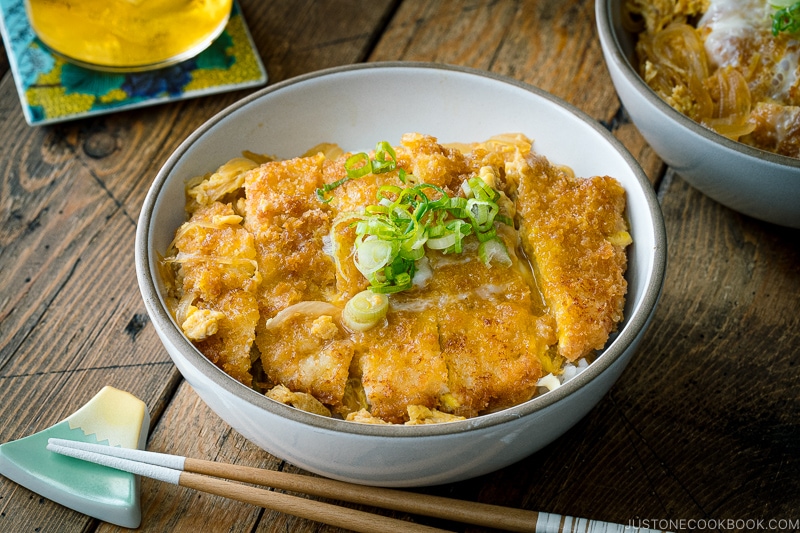
How to Make Katsudon
Ingredients You’ll Need
Ingredients You’ll Need
- Tonkatsu – regular deep-fried version or baked version
- Onion
- Broth – dashi (Japanese soup stock), sugar, mirin, and soy sauce
- Eggs
- Green onion
- Freshly steamed, Japanese short-grain rice
Overview: Quick Steps
- Make Tonkatsu (I have a very detailed recipe here) if you haven’t made yet.
- Cook the onion in the savory broth till tender.
- Place Tonkatsu on top to let it absorb the flavors of the broth.
- Add the beaten egg mixture and cook till just set.
- Serve over steamed rice and enjoy!
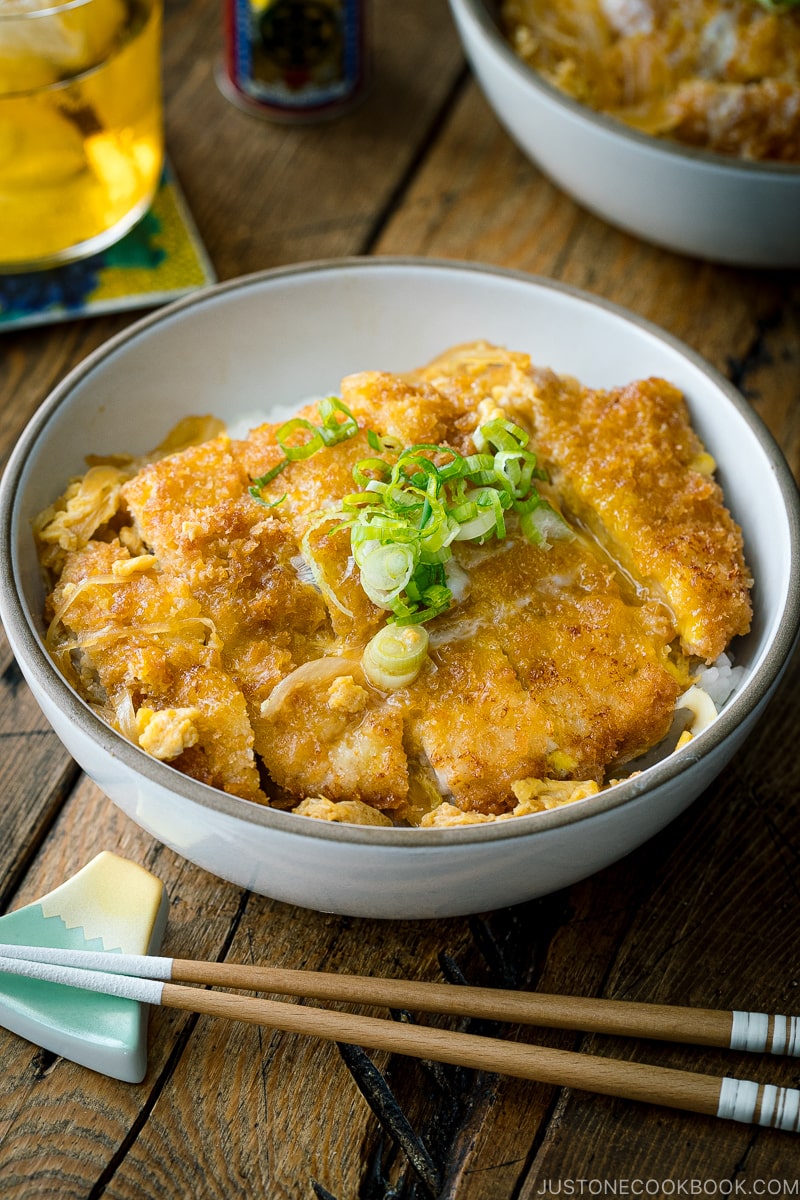
Helpful Tips to Make Katsudon
- Make sure to use a tight-fitting lid so the broth doesn’t evaporate too fast!
- The onion should be translucent and tender so they give sweet flavors to the dish.
- Should Tonkatsu be crispy? No, the bottom of the tonkatsu is supposed to absorb all the delicious broth flavor, and the top of the tonkatsu should be coated with creamy egg!
- Do not overcook the egg. Usually, it takes between 30-60 seconds for the egg to set. I make sure to buy fresh eggs for this kind of dish so we can enjoy its runny texture.
No Deep-Frying? Try My Baked Katsudon!
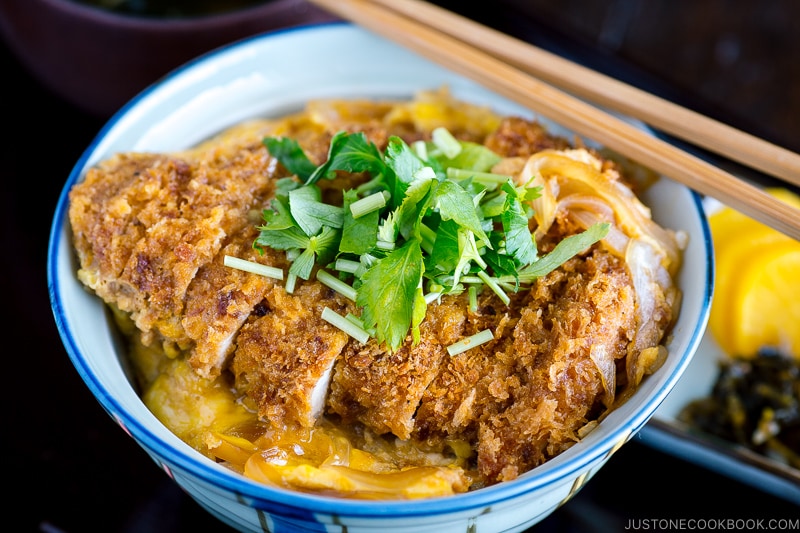
For those of you who still prefer a lighter version of tonkatsu and don’t want to deep-fry in your kitchen, you can check out my Baked Katsudon recipe. It’s wildly popular, and JOC fans simply love it!
Eat Katsudon for Luck!
Because “katsu” is also a Japanese word meaning “to win (勝つ),” katsudon is a dish that students and athletes eat on the day of, or the day before, big exams or games. So, the next time you have a test or competition where you need a good luck charm, consider this recipe!
Love Donburi? Check out these 12 popular rice bowl recipes!
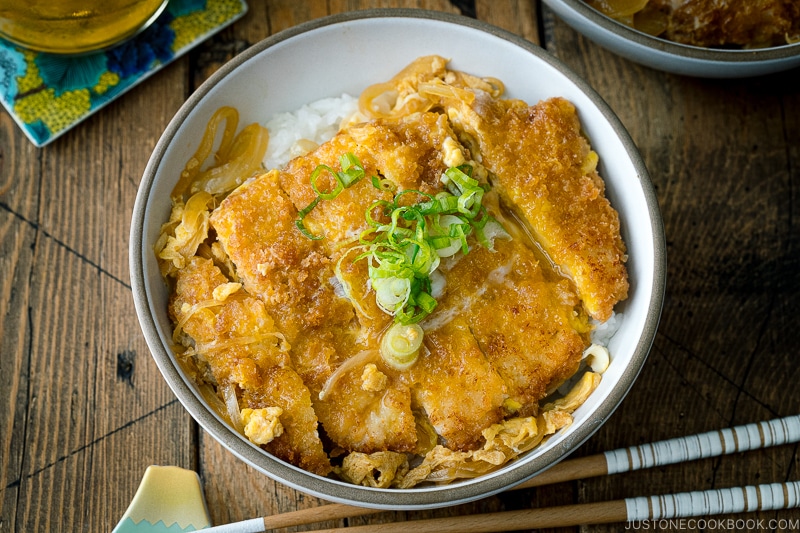
Wish to learn more about Japanese cooking? Sign up for our free newsletter to receive cooking tips & recipe updates! And stay in touch with me on Facebook, Pinterest, YouTube, and Instagram.
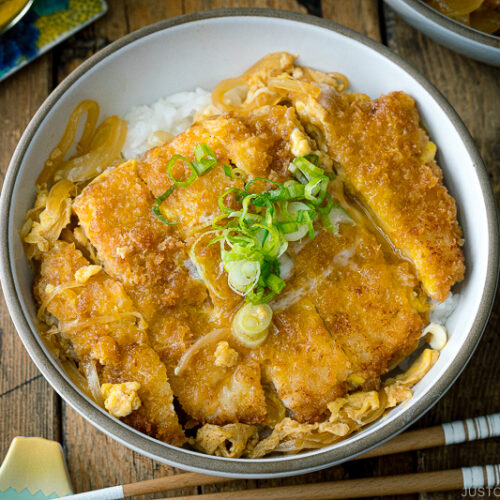
Katsudon
Video
Ingredients
For the Seasonings
- 1 cup water (for the dashi packet)
- 1 dashi packet (use standard Awase Dashi, dashi packet or powder, or Vegan Dashi)
- 2 tsp sugar
- 2 Tbsp mirin
- 2 Tbsp soy sauce
For the Katsudon
- ½ onion (4 oz, 113 g)
- 1 green onion/scallion (for garnish)
- 3 large eggs (50 g each w/o shell)
- 2 tonkatsu (breaded and fried pork cutlet; make the regular deep-fried version or my baked version)
- 2 servings cooked Japanese short-grain rice (typically 1⅔ cups (250 g) per donburi serving)
Instructions
- Before You Start: Gather all the ingredients. For the steamed rice, please note that 1½ cups (300 g, 2 rice cooker cups) of uncooked Japanese short-grain rice yield 4⅓ cups (660 g) of cooked rice, enough for 2 donburi servings (3⅓ cups, 500 g). See how to cook short-grain rice with a rice cooker, pot over the stove, Instant Pot, or donabe.

To Make the Dashi
- In a small pot, add 1 cup water and 1 dashi packet. Start cooking over medium heat. Tip: While I used a dashi packet here, you can substitute it with standard Awase Dashi, dashi powder, or Vegan Dashi. If you‘re new to dashi, learn more about it by reading my ultimate dashi guide.

- After it starts boiling, reduce the heat to medium-low heat and simmer for 2 minutes. Shake the bag a few times to get more flavors out. Discard the packet and dashi is ready to use.

To Prepare the Ingredients
- Thinly slice ½ onion and 1 green onion/scallion. I highly recommend cutting the onion thinly to reduce the cooking time.

- Crack 3 large eggs (50 g each w/o shell) into a medium bowl. Using a pair of chopsticks, lift the egg whites to “cut“ them 5–6 times into a few smaller clumps so the yolks and whites are marbled. This will prevent the egg whites from falling into the frying pan all at once. Do not whisk or beat the eggs together. Tip: Aim for high color contrast between the white and yellow parts of the eggs in your finished dish.

- Cut 2 tonkatsu into pieces 1 inch (2.5 cm) thick.

To Cook the Katsudon
- In a large frying pan that can fit 2 tonkatsu pieces, place the onion slices in a single layer. Then, add the dashi to the pan.

- Cover the frying pan with a tight-fitting lid (so the broth does not evaporate too quickly). Then, turn on the heat to medium and start cooking until the onion is tender and almost translucent.

- Then, add 2 tsp sugar and 2 Tbsp mirin.

- Add 2 Tbsp soy sauce and mix together.

- Place the tonkatsu over the onion and cover with the lid to reheat the tonkatsu, about 2 minutes. The bottom of the tonkatsu will absorb the broth.

- Once the tonkatsu is reheated and the broth is simmering, evenly distribute the egg over the tonkatsu and onion in a circular pattern, avoiding the edges of the pan where the egg can easily overcook. (If you prefer to cook your green onion slices, add them over the egg mixture now.) Cover with the lid for 1 minute, or until the egg is just set.

To Serve
- Divide 2 servings cooked Japanese short-grain rice into large donburi bowls. Place the tonkatsu, onion, and egg mixture on top. Drizzle with extra broth, if you‘d like. Garnish with sliced green onion and serve immediately.

To Store
- You can keep the leftovers in an airtight container and store them in the refrigerator for up to 3–4 days.
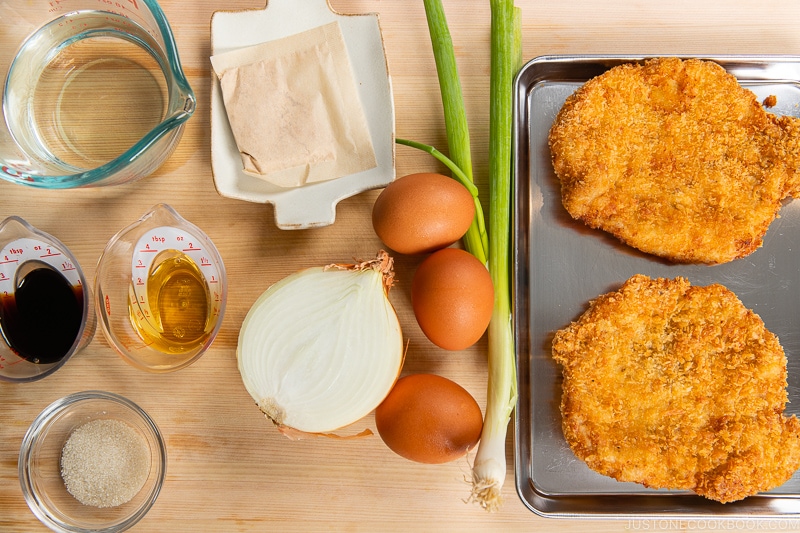
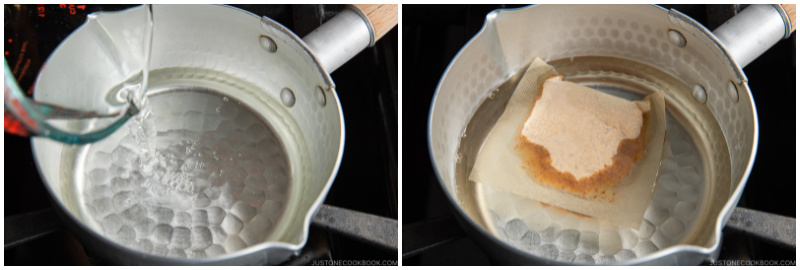
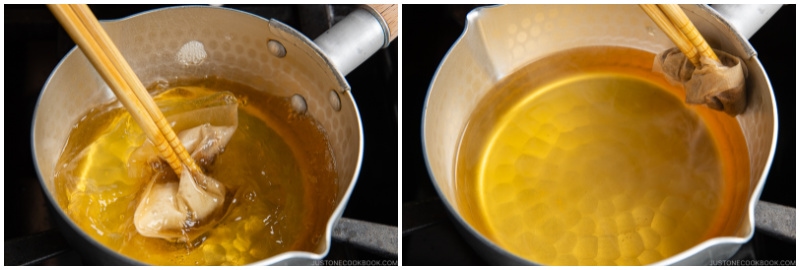
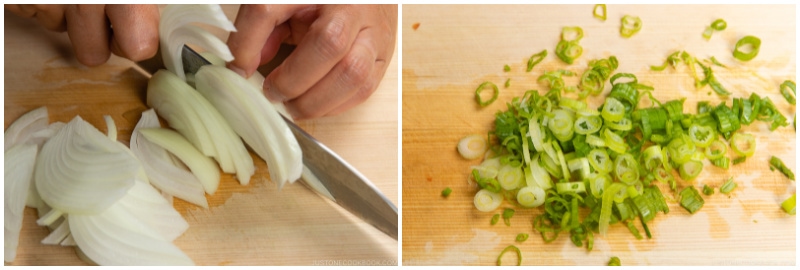
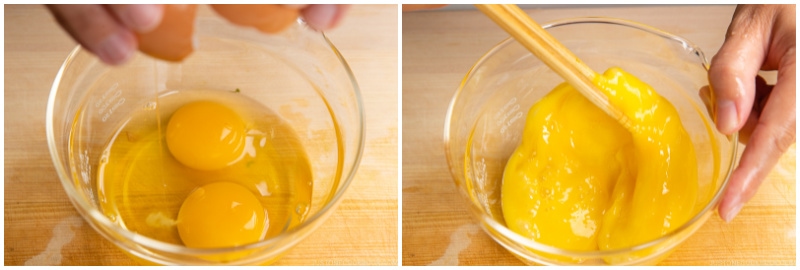
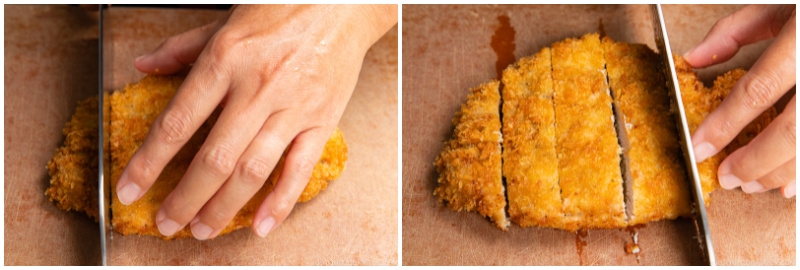
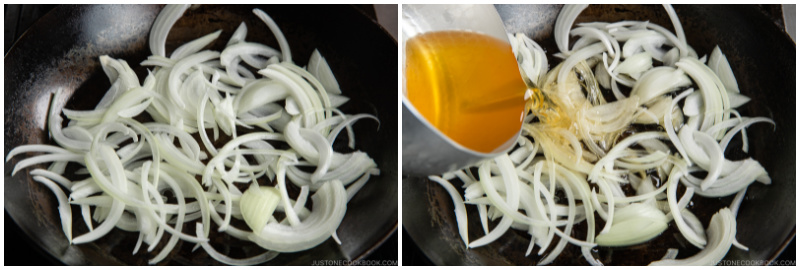

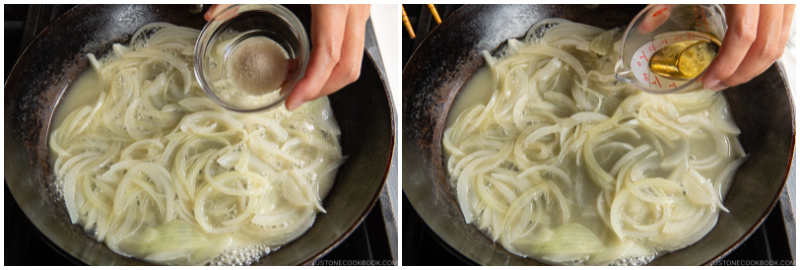
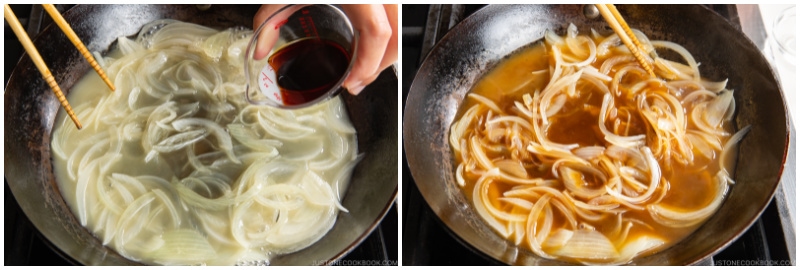
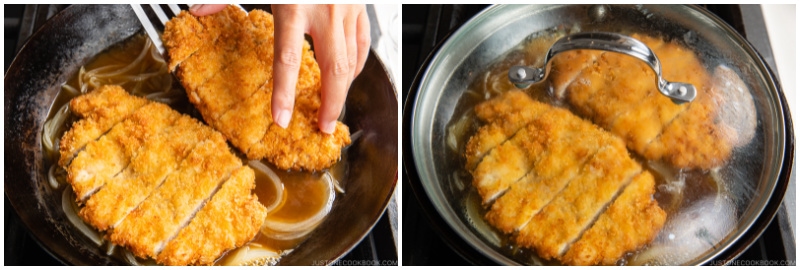
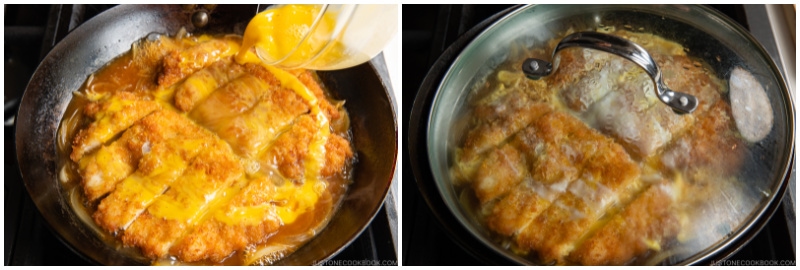
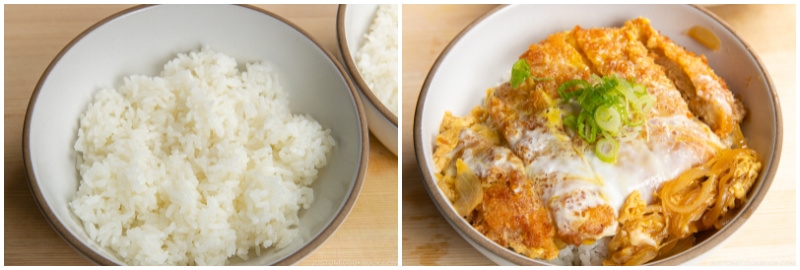


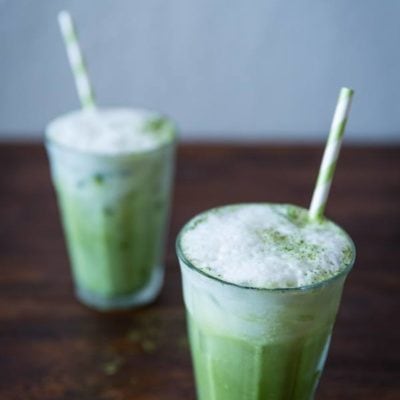

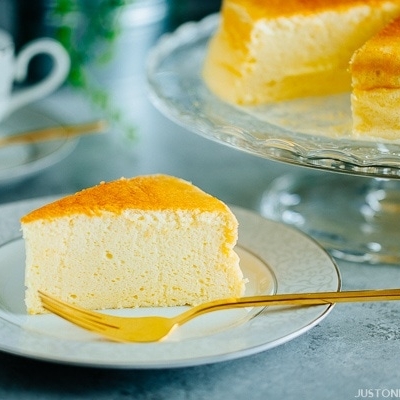


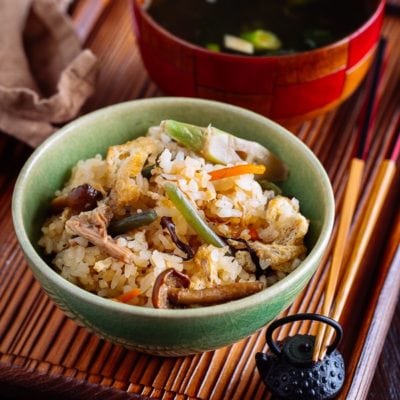
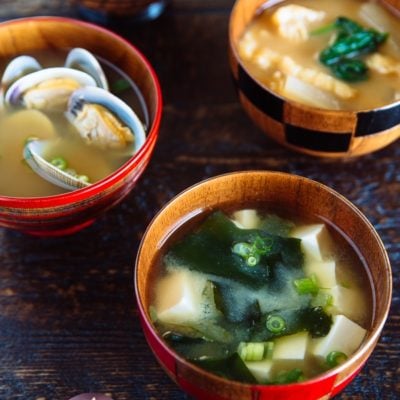

Dear Nami,
what to do with the lefover broth? Is it poured over the rice? Or did it evaporate mostly? Or do you use it for something else to season?
Thank you.
Hello there, Anna! Thank you very much for trying Nami’s recipe!
Most of them are made with eggs and will not have much left in the pan. However, the leftover broth can be drizzled over the rice and katsudon.
We hope this helps!
Hello! This sounds delicious but I am curious about why you fry the pork and get it nice and crispy but then put it in broth where the breading gets soggy. Will it still be good?
Hello there, Rose! That, we believe, is your preference. Someone has requested that the crispy Katsu separatory be served alongside this meal as well.
We hope you will try this katsudon!😊
What if I were to make my own dashi instead of using a dashi packet? How much should I use?
Hi Ryan, Thank you so much for trying Nami’s recipe!
You can replace the water amount with Dashi, so you will need 1 cup of Dashi to make this recipe.
We hope this helps!
Hi Namiko, I am very happy having found this recipe from the japanese home cooker such as yourself! I am wondering wheter I could replace dashi with hondashi power since I cannot find the packet version here. How much should I use hondashi for 2 servings? Thank you!
Hi Fai, Thank you for reading Nami’s post and trying her recipes.
You can mix 1/2 teaspoon Hondashi with 1 cup of water for this recipe (for 2 servings).
We hope this helps!
Thank you for sharing
Hi Fluke! You are very welcome!
We hope you enjoyed making Katsudon. Happy Cooking!
I lived in Japan for a year (2016-2017), and the food was the best thing about being there.
I used to get katsudon at least once a week, and I’ve missed it.
This recipe hit the spot.
Finding this website was truly an oasis in a proverbial desert.
Hi Koko! Aww. We are so happy for you that we could help recreate your memorable food in Japan.
Thank you for trying Nami’s recipe and for sharing the experience.
Happy Cooking! 😊
Fantastic recipe. So easy to make. I’ve made this twice and both recipients thoroughly enjoyed it.
Hi Monica! Thank you very much for trying Nami’s recipe and for your kind feedback!
Happy Cooking!
Hello! I never write reviews but I wanted to write one today to tell you that this recipe is fantastic! 🙂 I made your tonkatsu yesterday and today I made the leftovers into your katsudon and even my picky boyfriend loved it. ^^
I did not have any dashi or kombu whatsoever so I substituted it with chicken broth with a pinch of MSG, and it turned out delicious!! So if anyone wants to try this recipe but does not have dashi broth readily available, you can substitute it 😀
Thank you for always posting such wonderful recipes, I have tried multiple recipes of yours and I will continue to stay loyal to your site <3 thank you for your hard work!!
Hi Corinne! Thank you very much for trying Nami’s recipe and sharing your experience with us!
We are so happy to hear you had enjoyed many recipes include this Katsudon.😊
Thank you very much for your love and support. Happy Cooking!
Hi Nami! I’m so glad you made this recipe because I have been craving this for forever lol! Anyway yes I made this for dinner tonight and it was so so good! It’s a little hard since I have to use 2 pans because I cook for 6 people(I made 12 pork..whew!) so I had to kinda figure out how much dashi and sauce I had to put in each pan. In the end it still came out AMAZING!!😋 Thanks again for sharing this recipe!
Hi Mariko! 🤩 for 6 people!!! Awesome!
Thank you very much for trying Nami’s recipe and sharing your cooking experience with us!
Nami and JOC team are so happy to hear Katsudon came out Amazing! Happy Cooking!
Hello Namiko
I’m in BC Canada where I can buy HP FRUITY sauce for four dollars or less if it’s on sale. I’m wondering if the HP Fruity sauce .could be used in place of the bull dog sauce you recommend as the bulldog is quite expensive in my shops and online? They seem quite similar via ingredients listed, so thought I’s ask.
Also checked how much the Dashi packets you recommend were on amazon canada, and the cheapest one was $54 CD plus $15.05 CD shipping for 8 dashi packets, so that’s out. I’d not pay that much money for an ingredient I needed unless I was making a meal for the Royal Family!
Seriously though, I’d really like your opinion on the HP Fruity sauce.
Here’s some info about the sauce via the Sainsbury’s UK website.
Deliciously MILD & TANGY.
HP Fruity Brown Sauce, a unique mild and tangy brown sauce made from a subtle blend of high quality fruits with a hint of spices.
HP Fruity sauce adds a twist to your favourite sandwiches or as an accompaniment to hot or cold snacks.
NO ARTIFICIAL COLOURS.
NO ARTIFICIAL FLAVOURS.
NO ARTIFICIAL PRESERVATIVES.
SUITABLE FOR VEGETARIANS.
Ingredients
By Appointment to Her Majesty The Queen Purveyors of HP Sauces HP Foods Ltd, Hayes, Middx.
Thanks Namiko
Hi Joycelyn! Thank you very much for reading Nami’s post and trying her recipes!
We have never tasted the HP fruity sauce before and are unsure if it has the same flavor and taste as Bulldog Sauce. However, Nami has a homemade Tonkatsu sauce recipe using Worcestershire sauce as an ingredient. This sauce recipe is very close to Bulldog Sauce. https://www.justonecookbook.com/tonkatsu-sauce-recipe/
As for the Dashi packets, We are sorry to hear that it’s costly! Here in the US, they are (8g packets x 30 bags) for about $30. We recommend checking your local Asian store or other online shops for a better price.
https://www.justonecookbook.com/japanese-grocery-stores-around-the-world/
https://www.justonecookbook.com/online-shops-for-asian-ingredients-goods/
We hope this helps. 🙂